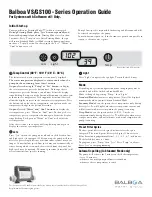
5 Application guidelines
Installer reference guide
15
ERLQ004~0 EHVH/X04+0 EHVH/X08S26CA
Daikin Altherma - Low Temperature Split
4P313775-1C – 2012.11
▪ Setup: Connect the following field wiring:
L
N
H
Com
A
K2A
K1A
X2M
BTI
K2A
K1A
Indoor/Auto/Boiler
1 2 3 4
X Y
Indoor
B
TI
Boiler thermostat input
A
Auxiliary contact (normal closed)
H
Heating demand room thermostat (optional)
K1A
Auxiliary relay for activation of indoor unit (field
supply)
K2A
Auxiliary relay for activation of boiler (field supply)
Indoor
Indoor unit
Auto
Automatic
Boiler
Boiler
NOTICE
▪ Make sure the auxiliary contact has enough differential
or time delay to prevent frequent changeover between
indoor unit and auxiliary boiler.
▪ If the auxiliary contact is an outdoor temperature
thermostat, install the thermostat in the shadow so that
it is NOT influenced or turned ON/OFF by direct
sunlight.
▪ Frequent changeover may cause corrosion of the
auxiliary boiler. Contact the manufacturer of the
auxiliary boiler for more information.
5.4
Setting up the domestic hot water tank
The DHW tank can be:
▪ Integrated in the indoor unit
▪ Installed standalone as option
5.4.1
System layout – Integrated DHW tank
Only for EHVH/X.
FHL1
FHL2
FHL3
M
UI
a
b c
d
h
h
i
f
e
g
a
Outdoor unit
b
Indoor unit
c
Heat exchanger
d
Backup heater
e
Pump
f
Motorised 3
‑
way valve
g
DHW tank
h
Shut-off valve
i
Collector (field supply)
FHL1...3
Under floor heating
UI
User interface
5.4.2
System layout – Standalone DHW tank
Only for EHBH/X.
FHL1
FHL2
FHL3
M
a
b c
d e
h
f
g
f
i
j
a
Outdoor unit
b
Indoor unit
c
Heat exchanger
d
Backup heater
e
Pump
f
Shut-off valve
g
Motorised 3
‑
way valve
h
Collector (field supply)
i
DHW tank
j
Heat exchanger coil
FHL1...3
Under floor heating
5.4.3
Selecting the volume and desired
temperature for the DHW tank
People experience water as hot when its temperature is 40°C.
Therefore, the DHW consumption is always expressed as equivalent
hot water volume at 40°C. However, you can set the DHW tank
temperature at a higher temperature (example: 53°C), which is then
mixed with cold water (example: 15°C).
Selecting the volume and desired temperature for the DHW tank
consists of:
1
Determining the DHW consumption (equivalent hot water
volume at 40°C).
2
Determining the volume and desired temperature for the DHW
tank.
Possible DHW tank volumes
Type
Possible volumes
Integrated DHW tank
▪ 180 l
▪ 260 l
Standalone DHW tank
▪ 150 l
▪ 200 l
▪ 300 l
Energy saving tips
▪ If the DHW consumption differs from day to day, you can program
a weekly schedule with different desired DHW tank temperatures
for each day.
▪ The lower the desired DHW tank temperature, the more cost
effective. By selecting a larger DHW tank, you can lower the
desired DHW tank temperature.
▪ The heat pump itself can produce domestic hot water of maximum
55°C (50°C if outdoor temperature is low). The electrical
resistance integrated in the heat pump can higher this
Summary of Contents for ERLQ004~008CAV3
Page 111: ......
















































